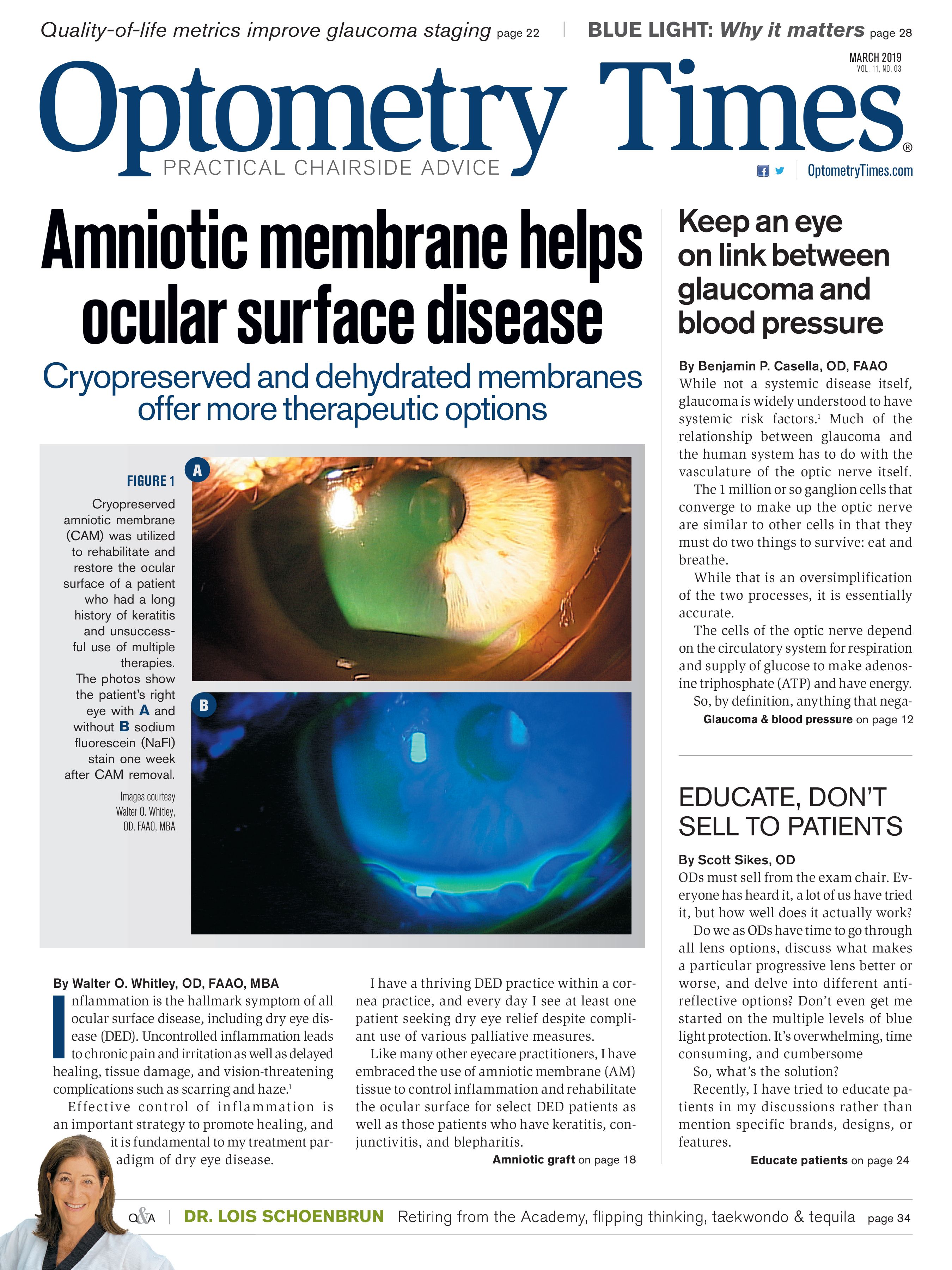Keep an eye on link between glaucoma and blood pressure


While not a systemic disease, glaucoma is widely understood to have systemic risk factors.1 Much of the relationship between glaucoma and the human system has to do with the vasculature of the optic nerve itself.
The 1 million or so ganglion cells that converge to make up the optic nerve are similar to other cells in that they must do two things to survive: eat and breathe.
While that is an oversimplification of the two processes, it is essentially accurate.
Previously by Dr. Casella: Legislative session offers opportunity to join in
Optic nerve cells
The cells of the optic nerve depend on the circulatory system for respiration and supply of glucose to make adenosine triphosphate (ATP) and have energy.
So, by definition, anything that negatively affects the vascular system has the potential to negatively affect the optic nerves.
Diabetes mellitus, for example, has long been proposed as a risk factor of the development of open-angle glaucoma. The evidence for this may be more compelling than ever before.2-4
With that said, the relationship between blood pressure and glaucoma has been studied for quite some time.5 Specifically, low blood pressure has been implicated as having a role in the development of open-angle glaucoma, especially in so-called normal tension glaucoma.6,7
With the recent publication of new blood pressure guidelines8 set forth by the American College of Cardiology and the American Heart Association, it is timely to analyze the relationship between blood pressure and glaucoma.
Related: How to diagnose a optic nerve
Supporting research
In a 2018 study published in the American Journal of Hypertension, the presence of glaucoma was determined to have a nonlinear relationship with blood pressure.9
The relationship between the two followed a U-shaped curve, according to the study’s investigators. This means that the incidence of glaucoma increased in those with low and high blood pressure.
The study included 4,137 participants from the 2005 to 2008 National Health and Nutrition Examination Surveys (NHANES), all age 40 or older.
The overall prevalence of glaucoma in the study sample was 1.2 percent. Systolic and diastolic blood pressure, separately, were used as metrics to determine the relationship between these two chronic diseases.
For participants not taking antihypertensive medications, the incidence of glaucoma went up with both high systolic blood pressure (greater than or equal to 161 mm Hg) and low systolic blood pressure (less than or equal to 110 mm Hg).
Similarly, the incidence of glaucoma went up with respect to high and low diastolic blood pressure (greater than or equal to 91mmHg or less than or equal to 60mmHg, respectively).
Related: Why ODs should monitor hypertension in patients
The prevalence of glaucoma among study participants was lowest in those with systolic blood pressure between 111mmHg and 120mmHg and diastolic blood pressure between 81mmHg and 90mmHg.
This study suggests a sort of “Goldilocks scenario” of blood pressure is preferred with respect to glaucoma, wherein an optimum range exists.
Blood pressure that is too low-naturally or from the overtreatment of hypertension-may lead to decreased ocular perfusion pressure and result in ischemia to the optic nerve.10
This factor may be especially significant in the arena of normal tension glaucoma.11
On the other hand, systemic hypertension, while perhaps not damaging in the short term, often leads to arteriosclerosis, which may decrease perfusion to the optic nerve.12
Related: When to send your hypertensive patient to the ER
Controversial link
The relationship between systemic hypertension and glaucoma has traditionally been one of controversy.
In fact, the 2008 Barbados Eye Studies showed that systemic hypertension may have an association with a decreased risk for glaucoma.13
However, newer research suggests the contrary, with systemic hypertension implicated as having a role in the development of ocular hypertension.14
Also by Dr. Casella: The case of the single fixed pupil
Putting into practice
So, with contemporary science suggesting that a range of blood pressure that is not too high and not too low is best for the patient, the question arises of what ODs can do with this information.
Incorporating blood pressure measurement into a glaucoma evaluation-if not already doing so-is a noninvasive and quick way of determining the presence or absence of a separate risk factor for the development of the disease.
It is incorrect to assume that a patient’s blood pressure is “controlled” simply because he is taking an oral antihypertensive medication. In fact, oral antihypertensive medication use is a common cause of hypotension.15
In addition to the fact that suboptimal blood pressure can contribute to glaucoma, nonselective beta blockers, such as timolol (Timoptic, Betimol; Alcon), are known to have systemic hypotension and bradycardia in their side effect profiles.16
Keeping check on such metrics aids in monitoring patient safety in addition to keeping an eye on potential lurking variables.
References:
1. McMonnies CW. Glaucoma history and risk factors. J Optom. 2017 Apr-Jun;10(2):71-78.
2. Zhao D, Cho J, Kim MH, Friedman DS, Guallar E. Diabetes, fasting glucose, and the risk of glaucoma: a meta-analysis. Ophthalmology. 2015 Jan;122(1):72–78.
3. Gupta D, Chen PP. Glaucoma. Am Fam Physician. 2016 Apr 15;93(8):668-74.
4. Zhou M, Wang W, Huang W, Zhang X. Diabetes mellitus as a risk factor for open-angle glaucoma: a systematic review and meta-analysis. PLoS One. 2014 Aug 19;9(8):e102972.
5. Duke-Elder S. Primary glaucoma as a vascular disease; the James A. Craig prize lecture. Ulster Med J. 1953 May 1;22(1):3-16.
6. Binggeli T, Schoetzau A, Konieczka K. In glaucoma patients, low blood pressure is accompanied by vascular dysregulation. EPMA J. 2018 Dec;9(4):387-391.
7. Muthu Krishnan V, Datta Gulnar P, Vasudev Anand R, Vijayakumar C, Balasubramaniyan G. Ocular and systemic risk factors and correlation with glaucomatous damage in normal tension glaucoma. Cureus. 2018 May 16;10(5):e2638.
8. Whelton PK, Carey RM, Aronow WS, Casey DE, Collins KJ, Dennison Himmelfarb C, DePalma SM, Gidding S, Jamerson KA, Jones DW, MacLaughlin EJ, Ovbiagele B, Smith SC, Spencer CC, Stafford RS, Taler SJ, Thomas RJ, Williams KA, Williamson JD, Wright JT. 2017 Guideline for the prevention, detection, evaluation, and management of high blood pressure in adults. J Am Coll Cardiol. Sep 2017, 23976.
9. Kim H, Choi B. Non-linear relationship between blood pressure and glaucoma in U.S. adults. Am J Hypertens. 2018 Dec 8. doi: 10.1093/ajh/hpy186
10. Chung HJ, Hwang HB, Lee NY. The association between primary open-angle glaucoma and blood pressure: two aspects of hypertension and hypotension. Biomed Res Int. 2015 Aug;2015: 827516.
11. Jin SW, Noh SY. Long-term clinical course of normal-tension glaucoma: 20 years of experience. J Ophthalmol. 2017 Apr 5;2017:2651645.
12. Memarzadeh F, Ying-Lai M, Chung J, Azen SP, Varma R; Los Angeles Latino Eye Study Group. Blood pressure, perfusion pressure, and open-angle glaucoma: the Los Angeles Latino Eye Study. Invest Ophthalmol Vis Sci. 2010 Jun;51(6):2872-7.
13. Leske MC, Wu SY, Hennis A, Honkanen R, Nemesure B; BESs Study Group. Risk factors for incident open-angle glaucoma: the Barbados Eye Studies. Ophthalmology. 2008 Jan;115(1):85-93.
14. Zhao D, Cho J, Kim M. H, Guallar E. The association of blood pressure and primary open-angle glaucoma: a meta-analysis. Am J Ophthalmol. 2014 Sep;158(3):615.e9–627.e9.
15. Figueroa JJ, Basford JR, Low PA. Preventing and treating orthostatic hypotension: as easy as A, B, C. Cleve Clin J Med. 2010 May;77(5): 298–306.
16. Lu HT, Kam J, Nordin RB, Khelae SK, Wang JM, Choy CN, Lee CY. Beta-blocker use and risk of symptomatic bradyarrhythmias: a hospital-based case-control study. J Geriatr Cardiol. 2016 Sep;13(9):749-759.

Newsletter
Want more insights like this? Subscribe to Optometry Times and get clinical pearls and practice tips delivered straight to your inbox.